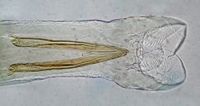Difference between revisions of "Amidostomum"
| (11 intermediate revisions by 2 users not shown) | |||
| Line 1: | Line 1: | ||
| − | |||
{{Taxobox | {{Taxobox | ||
|name =Amidostomum spp. | |name =Amidostomum spp. | ||
|kingdom =Animalia | |kingdom =Animalia | ||
| − | |phylum = | + | |phylum =Nematoda |
|class =Secernentea | |class =Secernentea | ||
|sub-class = | |sub-class = | ||
|order =Strongylida | |order =Strongylida | ||
| − | |super-family = | + | |super-family =Trichostrongyloidea |
|family =Amidostomatidae | |family =Amidostomatidae | ||
|sub-family =Amidostomatinae | |sub-family =Amidostomatinae | ||
| Line 13: | Line 12: | ||
|species =''A. anseris'', ''A. skrjabini'' | |species =''A. anseris'', ''A. skrjabini'' | ||
}} | }} | ||
| − | |||
| − | |||
| − | |||
| − | |||
| − | |||
| − | |||
| + | == ''Amidostomum anseris'' == | ||
| + | [[File:Amidostomum anseris.jpg|200px|thumb|right|''Amidostomum anseris'' ]] | ||
| + | This is a gizzard worm of aquatic fowl, most commonly of geese and ducks, found throughout the world. It is a member of the Trichostrongyloid family and has a life cycle typical of this family. | ||
====Identification==== | ====Identification==== | ||
| − | Adult worms are slender and bright red in colour, and as with most nematodes the females are larger then the males reaching 15 - 25mm. The worms are characterised by the presence of a shallow buccal capsule with three pointed teeth of which the middle tooth is the largest. | + | Adult worms are slender and bright red in colour, and as with most nematodes the females are larger then the males reaching 15 - 25mm. The worms are characterised by the presence of a shallow buccal capsule with three pointed teeth of which the middle tooth is the largest. |
| + | |||
| + | *A trichostrongyloid. | ||
| + | *Found in ducks and geese. | ||
| + | *Red in colour. | ||
| + | *Lives under the lining of the gizzard. | ||
| + | *Life-cycle resembles that of ''Nematodirus'' in sheep. | ||
| + | *A frequent cause of mortality in ornamental ducks. | ||
==''Amidostomum skrjabini''== | ==''Amidostomum skrjabini''== | ||
This species is similar to ''A. anseris'' above in appearance. The major host for this nematode are both domestic and wild duck species and it can be found worldwide. The main defining feature of this species is the requirement for hatched L3 larvae to exist for about 5 days in the environment before being fully infectious. | This species is similar to ''A. anseris'' above in appearance. The major host for this nematode are both domestic and wild duck species and it can be found worldwide. The main defining feature of this species is the requirement for hatched L3 larvae to exist for about 5 days in the environment before being fully infectious. | ||
| − | |||
| − | |||
| − | |||
| − | |||
| − | |||
| − | |||
| − | |||
| − | |||
| − | |||
[[Category:Trichostrongyloidea]] | [[Category:Trichostrongyloidea]] | ||
| − | [[Category: | + | [[Category:Poultry_Nematodes]] |
| − | [[Category: | + | [[Category:To_Do_-_NickJ]] |
Revision as of 15:32, 28 July 2010
| Amidostomum spp. | |
|---|---|
| Kingdom | Animalia |
| Phylum | Nematoda |
| Class | Secernentea |
| Order | Strongylida |
| Super-family | Trichostrongyloidea |
| Family | Amidostomatidae |
| Genus | Amidostomum |
| Species | A. anseris, A. skrjabini |
Amidostomum anseris
This is a gizzard worm of aquatic fowl, most commonly of geese and ducks, found throughout the world. It is a member of the Trichostrongyloid family and has a life cycle typical of this family.
Identification
Adult worms are slender and bright red in colour, and as with most nematodes the females are larger then the males reaching 15 - 25mm. The worms are characterised by the presence of a shallow buccal capsule with three pointed teeth of which the middle tooth is the largest.
- A trichostrongyloid.
- Found in ducks and geese.
- Red in colour.
- Lives under the lining of the gizzard.
- Life-cycle resembles that of Nematodirus in sheep.
- A frequent cause of mortality in ornamental ducks.
Amidostomum skrjabini
This species is similar to A. anseris above in appearance. The major host for this nematode are both domestic and wild duck species and it can be found worldwide. The main defining feature of this species is the requirement for hatched L3 larvae to exist for about 5 days in the environment before being fully infectious.
